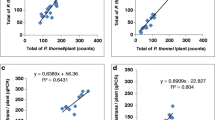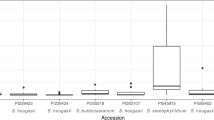Abstract
Twelve accessions ofSolarium fendleri collected in the United States and Mexico were inoculated with 5,000 eggs of host-races 1 and 2 ofMeloidogyne chitwoodi, Columbia root-knot nematode. The test seedlings that were derived from plant introduction true seed lots were maintained for 55 days before harvest and egg count. The results revealed that two accessions, PI 275162 and PI 275165, were non-hosts (final egg count/initial egg inoculation < 0.1) forM. chitwoodi race 1. The results were uniformly confirmed in the second experiment. No resistance was found to race 2. The tetraploidS. fendleri accessions were crossed to a nematode-susceptible cultivated diploid potato clone from aS. phurejastenotomum population. The triploid hybrids expressed resistance to race 1 at the non-host level. After somatic doubling, the resulting hexaploids also expressed non-host-level resistance to race 1. The two resistant accessions had been collected in southeastern Arizona, one each from the Huachuca and Chiricahua Mountains. Each range is an isolated island of high-elevation mesic flora surrounded by typical lowerelevation Sonora-type desert habitat. These accessions are the only known sources of resistance toM. chitwoodi from wildSolanum species in the USA.
Resumen
Doce accesiones deSolanum fendleri colectadas en los Estados Unidos y México se inocularon con 5,000 huevos de las razas 1 y 2 deMeloidogyne chitwoodi, nematodo del nudo de Columbia. Las plántulas en prueba, derivadas de una introducción de semilla botanica fueron mantenidas por 55 dias antes de cosecharlas y contar los huevos. Los resultados revelaron que dos de las accesiones, PI 275162 y PI 275165 no son hospedantes (conteo final de huevos / inoculación inicial de huevos < 0.1) para la raza 1 deM. chitwoodi. Los resultados fueron fielmente confirmados en el segundo experimento No se encontró resistencia a la raza 2. Las accesiones tetraploides deS. fendleri fueron cruzadas con un clon de papa cultivada diploide deS. phurejastenotomum de una población susceptible al nematodo. Los híbridos triploides expresaron resistencia a la raza 1 en el nivel de no-hospedante. Después de la duplicación somática, el hexaploide résultante también expresó resistencia a la raza 1 en el nivel de no-hospedante. Las dos accesiones resistentes han sido colectadas en el sudeste de Arizona, una en Huachuca y otra en Chiricahua Mountains. Cada monte es una isla aislada con flora de humedad media, rodeada de una elevación más baja del tipico habitat desértico de Sonora. Estas accesiones son la única fuente conocida de resistencia alM. chitwoodi de las especies silvestres de los EUA.
Similar content being viewed by others
Literature Cited
Austin S, JD Pohlman, CR Brown, H Mojtahedi, GS Santo, D Douches, and J Helgeson. 1993. Interspecific somatic hybridization betweenSolanum tuberosum L. andS. bulbocastanum DUN. as a means of transferring nematode resistance. Amer Potato J 70: 485–495.
Brown CR, H Mojtahedi, and GS Santo. 1989. Comparison of reproductive efficiencyof Meloidogyne chitwoodi onSolanum bulbocastanum in soil andin vitro tests. Plant Dis 73: 957–959.
Brown CR, H Mojtahedi, and GS Santo. 1991. Resistance to Columbia root-knot nematode inSolanum ssp. and in hybrids ofS. hougasii with tetraploid cultivated potato. Amer Potato J 68: 445–452.
Brown CR, H Mojtahedi, and GS Santo. 1995. Introgression of resistance to Columbia and Northern root-knot nematodes fromSolanum bulbocastanum into cultivated potato. Euphytica 83: 71–78.
Brown CR, H Mojtahedi and GS Santo. 1999. Genetic analysis of resistance toMeloidogyne chitwoodi introgressed fromSolanum hougasii in cultivated potato. J Nematol 31: 264–271.
Brown CR, H Mojtahedi, GS Santo, and S Austin-Phillips. 1994. Enhancing resistance to root-knot nematodes derived from wildSolanum species in potato germplasm.In: GW Zehnder, ML Powelson, RK Jansson, and KV Raman (eds), Advances in Potato Pest Biology and Management. Am Phytopathology Society, Minneapolis, MN. pp 426–438.
Brown CR, C-P Yang, H Mojtahedi, GS Santo, and R Masuelli. 1996. RFLP analysis of resistance to Columbia root-knot nematode derived fromSolanum bulbocastanum in a BC2 population. Theor Appl Genet 92: 572–576.
Culley DE, BB Dean, and CR Brown. 2002. Introgression of low browning trait from the wild Mexican speciesSolanum hjertingii into cultivated potato (S. tuberosum L). Euphytica 125: 293–303.
Evans K, and D Trudgill. 1992. Pest aspects of potato production, part I. The nematode pests of potatoes.In: P Harris (ed), The Potato Crop. Chapman and Hall, London. pp 438–475.
Golden AM, JH O’Bannon, GS Santo, and AM Finley. 1980. Description and SEM observation ofMeloidogyne chitwoodi n. sp. (Meloidogynidae), a root-knot nematode on potato in the Pacific Northwest. J Nematol 12: 319–351.
Hussey RS, and KR Barker. 1973. A comparison of methods of collecting inocula ofMeloidogyne spp. including a new technique. Plant Dis Rep 57: 1025–1028.
Janssen GJW, A van Norel, R Janssen, and J Hoogendoorn. 1997. Dominant and additive resistance to the root-knot nemotodesMeloidogyne chitwoodi, andM. fallax in Central AmericanSolanum species. Theor Appl Genet 94: 692–700.
Janssen GJW, A van Norel, B Verkerk-Bakker, and R Janssen. 1996. Resistance toMeloidogyne chitwoodi, M. fallax, andM. hapla in wild tuber-bearingSolanum spp. Euphytica 92: 287–294.
Johnston SA, and RE Hanneman Jr. 1982. Manipulations of endosperm balance number overcome crossing barriers between diploidSolanum species. Science 217: 446–448.
Marks GE. 1954. An acetocarmine glycerol jelly for use in pollen fertility counts. Stain Techn 29: 277.
Oostenbrink M. 1966. Major characteristics of the relation between nematodes and plants. Mded Lanbouwhogeschool, Wageningen 66: 3–46.
Santo GS, J O’Bannon, AP Nyczepir, and RP Ponti. 1981. Ecology and control of root-knot nematodes on potato.In: Proceeding 20th Annual Washington State Potato Conference and Trade Fair, Moses Lake, WA. pp 135–139.
Stock, SP, J Buckner, L Grossmiller, and P Coyne. 2003. Nematodes in oak woodlands from Southern Arizona’s Sky Islands. J Nematol (In Press).
Author information
Authors and Affiliations
Corresponding author
Rights and permissions
About this article
Cite this article
Brown, C.R., Mojtahedi, H. & Bamberg, J. Evaluation ofSolarium fendleri as a source of resistance toMeloidogyne chitwoodi . Am. J. Pot Res 81, 415–419 (2004). https://doi.org/10.1007/BF02870202
Accepted:
Issue Date:
DOI: https://doi.org/10.1007/BF02870202




